Dampierre-sur-Boutonne
| Dampierre-sur-Boutonne | ||
|---|---|---|
|
|
||
| region | Nouvelle-Aquitaine | |
| Department | Charente-Maritime | |
| Arrondissement | Saint-Jean-d'Angély | |
| Canton | Matha | |
| Community association | Vals de Saintonge | |
| Coordinates | 46 ° 4 ′ N , 0 ° 25 ′ W | |
| height | 31-83 m | |
| surface | 14.04 km 2 | |
| Residents | 282 (January 1, 2017) | |
| Population density | 20 inhabitants / km 2 | |
| Post Code | 17470 | |
| INSEE code | 17138 | |
 Dampierre-sur-Boutonne castle |
||
Dampierre-sur-Boutonne is a western French community with 282 inhabitants (at January 1, 2017) in the Charente-Maritime in the region Nouvelle-Aquitaine .
location
Dampierre-sur-Boutonne is about 50 meters above sea level. d. M. in the northeast of the historic cultural landscape of the Saintonge about 50 kilometers (driving distance) northeast of Saintes or also about 50 kilometers northwest of the city of Cognac . The capital of the canton, Aulnay , is only about eight kilometers south-east. The community of Matha with its two interesting churches is about 26 kilometers to the south. The river Boutonne flows through the village .
Population development
| year | 1968 | 1975 | 1982 | 1990 | 1999 | 2007 | 2016 |
| Residents | 416 | 385 | 348 | 335 | 297 | 299 | 279 |
economy
In the late Middle Ages, several water mills settled along the Boutonne , which - repeatedly modernized - were in operation until the late 19th century. While viticulture was practiced in the area for centuries in addition to agriculture, all of the vines were torn up at the end of the 19th century as a result of the phylloxera crisis and not replanted. Today the place lives mainly from the cultivation of grain ( wheat , corn , sunflowers , rape ) and from the livestock industry (milk, cheese).
history
The history of Dampierre-sur-Boutonne goes back to the Roman and Gallo-Roman times, when a fortified camp ( castrum ) stood nearby .
In 10./11. In the 17th century a castle was built, from which an octagonal stair tower was integrated into the 12th century church.
In the Hundred Years War (1337-1453) Dampierre temporarily fell into English hands until it was recaptured in 1373 by Bertrand du Guesclin for the French crown. During the Huguenot Wars from 1562 to 1598, both the church and the castle had to endure repeated attacks from the Protestants .
Attractions

See also: List of Monuments historiques in Dampierre-sur-Boutonne
- The largely unadorned single-nave Romanesque church of Saint-Pierre stands in the center of the village and dates from the 12th century, but was expanded in the 16th century with additions on the south side. Only the apse has an abstract, geometric ornamentation inside and out. The nave has a flat roof; a prepared rib vault was not carried out. A painted frieze with a coat of arms - comparable to those in Rétaud and Rioux - surrounds the walls. In the additions from the 16th century there is a coffered ceiling whose structure is comparable to that in the castle - only without the allegorical representations. The building was classified as a Monument historique in 1969 .
- The main attraction of Dampierre is the Renaissance castle of Dampierre-sur-Boutonne , which was surrounded by a moat , and construction began in 1495. The two still medieval -looking round towers date from that time . In the early 17th century, the two-story corps de logis was tackled, which opens onto the courtyard garden side through arcades . The arcade on the upper floor has an extraordinarily richly relief coffered ceiling with a multitude of allegorical figures, sayings, coats of arms, cryptic symbols, etc., most of which are taken from the emblem books of the time. The building was classified as a Monument historique in 1926 .
- There is a donkey breeding company in the vicinity of the village, which has set itself the task of preserving for posterity the large, shaggy Poitou donkeys , which used to be kept exclusively for mule breeding .
literature
- Le Patrimoine des Communes de la Charente-Maritime. Flohic Editions, Volume 1, Paris 2002, ISBN 2-84234-129-5 , pp. 119-122.
Individual evidence
- ↑ The Saint-Pierre church in the Base Mérimée of the French Ministry of Culture (French)
- ↑ Castle Dampierre-sur-Boutonne in the Base Mérimée of the French Ministry of Culture (French)
Web links
- Website of the municipality (French)
